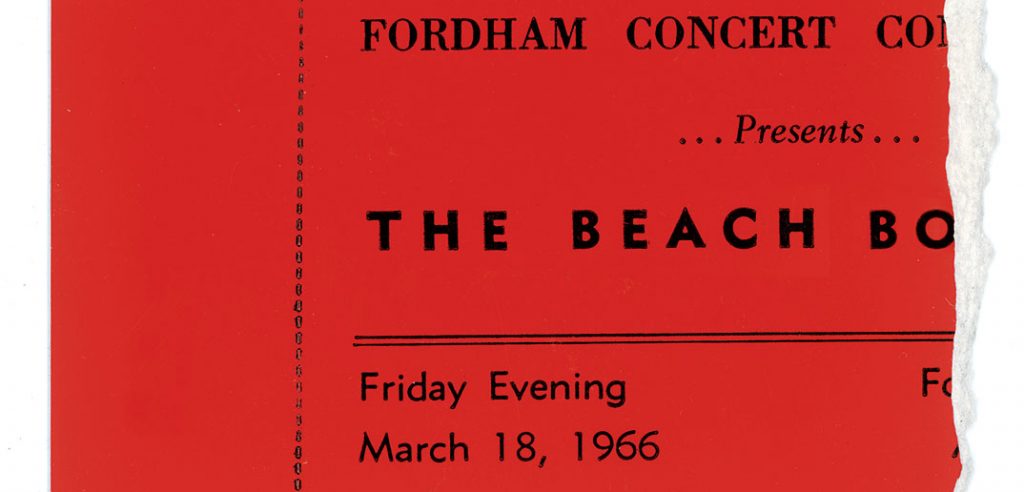From the Beach Boys and the Kinks to the Ramones and U2—a nostalgic look at the unexpected place Fordham holds in the New York music scene.
Think of live music in New York, and you’re likely to think of Madison Square Garden, concerts in Central Park, or the new Barclays Center in Brooklyn. More intimate, singer-songwriter shows might evoke thoughts of a small club in the Village or a sticky-floored hall on the Lower East Side or in Williamsburg. The leafy Bronx campus of a Jesuit university would probably not come to mind.
But with most performers traveling through its home city, and an award-winning public radio station staffed by prominent New York DJs, Fordham has hosted some of the biggest bands of all time. From the Beach Boys in the gym at the height of their popularity, to Adele at WFUV just after her debut, to U2 broadcasting live from Rose Hill on Good Morning America, the past five decades of popular music have been well represented on University grounds.
“Just the thought that the Beach Boys played at Fordham, that’s really cool,” says Darren DeVivo, FCRH ’87, evening host on WFUV (90.7 FM, wfuv.org), Fordham’s noncommercial public radio station. “And then look what happened with U2. It just shows you that quirky but cool place that Fordham holds within the New York music scene.”
During his 25-plus years at WFUV, DeVivo has welcomed more than a few music icons to the station’s studios in Keating Hall. He even interviewed Beach Boy Brian Wilson in 2008.
But a 1966 Beach Boys concert at Fordham was something else.
University Trustee Dennis Ruppel, FCRH ’68, was sophomore class president, and John Valente, FCRH ’68, was floor chairman of the concert committee that year. They decided to try to bring the surf rockers—one of the most popular acts in the country at the time—to Fordham to play the traditional sophomore concert. Bolstered by the audacity of youth, Ruppel called the band’s management, and the committee signed the Beach Boys to play at Rose Hill on March 18, 1966, along with the Lovin’ Spoonful.
“This is what was so great about the pre- Woodstock era,” says Valente, a former executive producer of network soap operas who runs two independent movie theaters in the Berkshires. “You’d look at the back of the LP, find the management company, and make a couple of phone calls.”
“It was very easy,” adds Ruppel, who brokered the deal with the William Morris agency. Still, signing the contract was nerve-racking. “When you have to come up with $7,500 you don’t take it lightly! It was a lesson in risk management—and I live today as the CEO of an insurance company,” says Ruppel, who heads Ark Royal homeowners insurance company and is a partner in the Florida-based law firm Johnson, Pope, Bokor, Ruppel & Burns, LLP.
Ruppel needn’t have worried; the committee sold so many tickets that it exercised its contract option to add another show on the same night.
The late New York DJ Pete Fornatale, FCRH ’67, who began his career as a student at WFUV and came back to the station in 2001, recalled the Beach Boys concert in an interview for this magazine shortly before he died in April 2012.
“Fordham was the place to be that night,” he said, “and fortunately for me I knew the concert committee and they knew FUV, and they set us up in the dressing room to do recordings.”
That meeting sparked a decades-long relationship between Fornatale and the Beach Boys. He emceed their 1971 comeback concert at Carnegie Hall, and the surviving members of the band recorded a video tribute that was played at his June 2012 memorial at the Hard Rock Cafe in New York.
Soon after that 1966 Beach Boys concert, Fordham students and other New Yorkers began flocking to Rose Hill to see bands that would later become legends: Simon and Garfunkel, the Four Tops, Buffalo Springfield, the Byrds, and many more in the ’60s and ’70s. Joan Jett, Squeeze, and 10,000 Maniacs, among others in the ’80s and ’90s. And no one will ever forget that chilly morning in 2009 when U2 played an electrifying set on Edwards Parade.
What follows is a collection of vignettes highlighting Fordham’s rock-and-roll reputation.
The Beach Boys with the Lovin’ Spoonful
March 18, 1966
Rose Hill Gymnasium
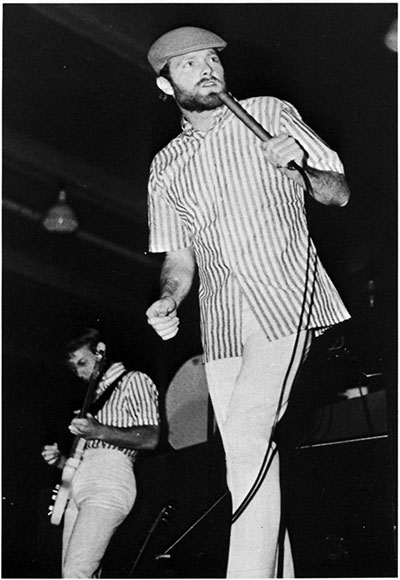
Led by native New Yorker John Sebastian, the Lovin’ Spoonful had a hit in 1965 with “Do You Believe in Magic?” but they were still relative newcomers when they signed on to open up for the Beach Boys. By March ’66 the band had a few more hits, including “Daydream,” and they were just a few months away from releasing one of their most enduring singles—“Summer in the City.” Yet they’d never played a gig as big as this one.
“To the Spoonful, it was a step up,” says Sebastian. “We had been playing high schools the year before, so to get a job at Fordham meant a tremendous amount to us.” The band was also excited to perform on a bill with the Beach Boys.
When the Lovin’ Spoonful showed up at the McGinley Center that night—in taxi cabs from the Village—someone mistakenly placed them in the faculty lounge reserved as the Beach Boys’ dressing room. When the Beach Boys pulled up in their limos and found another band in their room, “You could cut the tension with a knife,” says Dennis Ruppel.
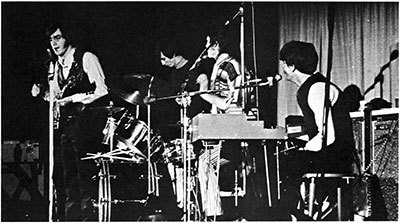
“I talked to John Sebastian and very kindly asked him to leave. He was very cool about it; he got it instantly.” But he left his autoharp behind. “One of the Beach Boys picked up the harp and was sitting on the couch playing it. [Sebastian] came back and there was again this high tension level,” Ruppel remembers, especially because the Beach Boy insisted on finishing his song.
As for the show? “It was great,” says Ruppel. “People were yelling and screaming. They played everything. ‘California Girls,’ ‘Little Deuce Coup,’ ‘Surfin’ Safari.’ It was one hit after another.”
The Supremes with Gladys Knight and the Pips
March 11, 1967
Rose Hill Gymnasium
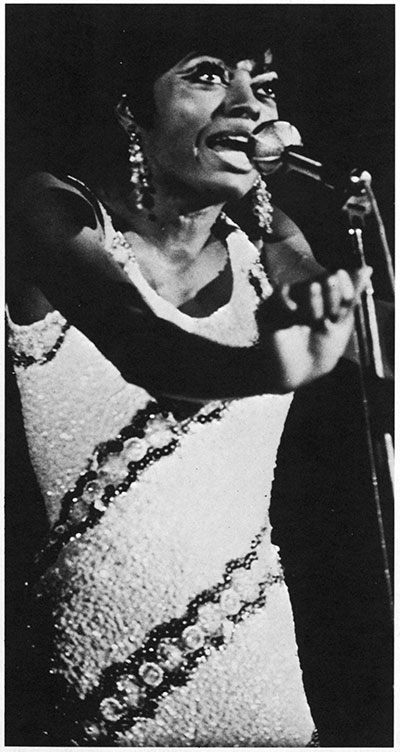
By 1966, the Supremes were international stars and Motown’s biggest act. Their catchy singles “Stop in the Name of Love,” “Back in My Arms Again,” and “You Can’t Hurry Love” along with the easy tone of Diana Ross’ voice, allowed the trio to cross over from R&B to pop, and made them one of the most successful groups of the decade. Gladys Knight and the Pips opened the show. “We caught them on the rise, just before they became headliners themselves,” recalls John Valente, FCRH ’68.
Mary Bruton Reid, TMC ’69, waitressed in the McGinley Center’s Ramskeller that evening and brought a tray of beers to the Supremes.
“They were just beautiful, in shimmering, glittery gowns,” says Reid. “They took complete control of the stage. Diana Ross had huge charisma.” When they introduced themselves during the show, Reid recalls, Ross said, “‘And me, I’m the skinny one,’ and did a sort of wiggle, and then they went into all their songs.’”
Kate Schumann, GABELLI ’83,’96, posted a memory of the show on the Fordham alumni Facebook page: “They let the neighborhood kids in for free. I was so small that I sat just below the stage. Afterwards, I was caught trying to sneak [into]the reception being held at the McGinley Center. A very fond memory!”
The Kinks with Aerosmith
March 30, 1973
Rose Hill Gymnasium
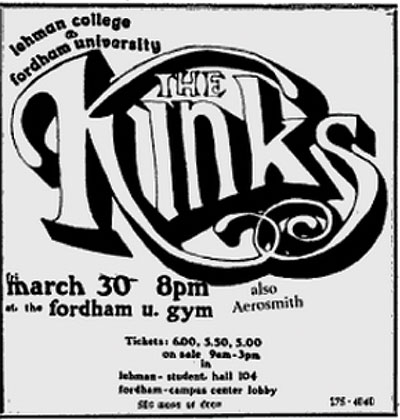 Nearly 10 years after “You Really Got Me” and “All Day and All of the Night” paved the way for the hard rock of future decades, the Kinks played at Rose Hill with Boston rockers Aerosmith. According to New York Times critic John Rockwell, the Kinks made it clear that night in the gym that “they are still one of the finest groups around.”
Nearly 10 years after “You Really Got Me” and “All Day and All of the Night” paved the way for the hard rock of future decades, the Kinks played at Rose Hill with Boston rockers Aerosmith. According to New York Times critic John Rockwell, the Kinks made it clear that night in the gym that “they are still one of the finest groups around.”
Rockwell gave most of the credit to front man Ray Davies, but also praised “the simple invention of their material and arrangements (a three-piece mini-Dixieland band was on hand) and the skill of their execution.” The writer had less-than-kind words for Aerosmith, who would release their debut album, including the now-classic “Dream
On,” two months later. The band “played loud, derivative rock, distinguished only by Steven Tyler’s fawning imitation of Mick Jagger.”
Kurtis Blow
February 26, 1983
McGinley Center Cafeteria
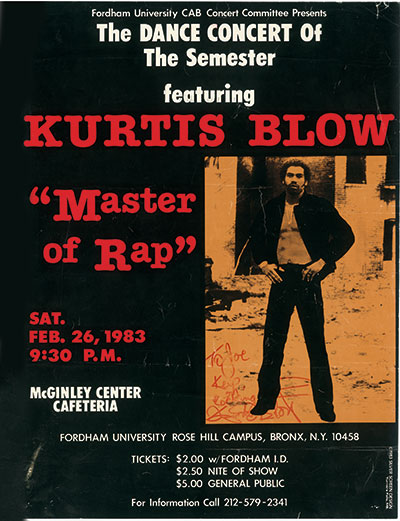 Three years after releasing “The Breaks”—the first-ever rap hit on a major label—Harlem-born Kurtis Blow played a sold-out show in the McGinley Center. Blow’s influence was so significant that rapper Run (aka Joseph Simmons) of the seminal hip-hop trio Run DMC, called himself “The Son of Kurtis Blow” when he was first starting out.
Three years after releasing “The Breaks”—the first-ever rap hit on a major label—Harlem-born Kurtis Blow played a sold-out show in the McGinley Center. Blow’s influence was so significant that rapper Run (aka Joseph Simmons) of the seminal hip-hop trio Run DMC, called himself “The Son of Kurtis Blow” when he was first starting out.

“It was a great performance. He was really, really entertaining,” says Joe Cerra, FCRH ’84, chairman of the concert committee at the time. “We had booked it as sort of a New York City nightclub. We opened the doors early and had a mixer with a DJ.”
Mimes and Mummers, the theater company at Rose Hill, had an earlier performance, Cerra recalls, and people were able to go to both shows for a full night out. “It was a really great night on campus.”
Billy Idol
December 2, 1983
Rose Hill Gymnasium
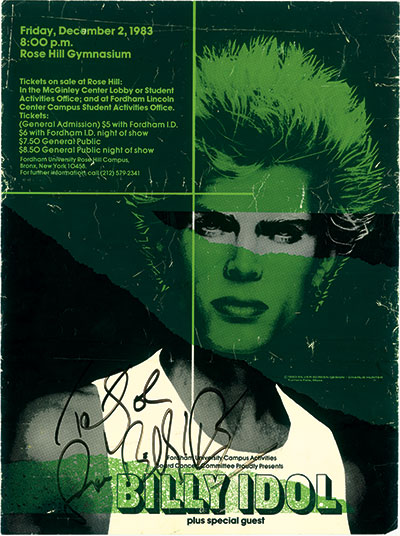 “The Billy Idol show got out of hand,” Cerra says of the winter concert by the English rocker. The concert committee booked the show before the 1983 summer break, when Idol’s single “White Wedding” was popular. They’d planned to sell 3,000 tickets at $5 each—the same price as the Beach Boys show nearly 20 years earlier. “We were never trying to make money,” says Cerra, now an attorney living in Suffern, N.Y.
“The Billy Idol show got out of hand,” Cerra says of the winter concert by the English rocker. The concert committee booked the show before the 1983 summer break, when Idol’s single “White Wedding” was popular. They’d planned to sell 3,000 tickets at $5 each—the same price as the Beach Boys show nearly 20 years earlier. “We were never trying to make money,” says Cerra, now an attorney living in Suffern, N.Y.
But before the fall rolled around, the new music-video craze had made Idol famous. “He got a lot of play on MTV that summer and was very, very hot,” Cerra says. “There’s no question there were more than 3,000 people in that gym.” Idol played all his big hits: “Rebel Yell,” “Mony Mony,” and “Dancin’ with Myself.” Teen idol Matt Dillon even showed up with Idol’s entourage. “The place was really rockin’,” says Cerra.
The Ramones
April 27, 1984
Rose Hill Gymnasium
 “We originally wanted the Go-Go’s. They were red hot at the time,” says Cerra. But the all-female group’s drummer needed open-heart surgery, and they canceled one month before the show.
“We originally wanted the Go-Go’s. They were red hot at the time,” says Cerra. But the all-female group’s drummer needed open-heart surgery, and they canceled one month before the show.
“The Ramones were available for that day, and we scooped them up,” says Cerra.
The iconic punk rock pioneers from Forest Hills, Queens, released their debut album in 1976 and toured relentlessly, playing often at the nowshuttered East Village venue CBGB. Even though the band’s popularity was waning by 1984, their hits had staying power. “At every college party you went to, ‘I Wanna Be Sedated’ was playing,” Cerra says. The show nearly sold out.
Backstage, the Ramones’ demands were few. “They were pretty straightforward and pretty down-to-earth guys,” says Cerra, although they did have one special request. Concert committee member Rich Srsich, GABELLI ’85, “had to keep giving Joey Ramone updates on the Knicks game.”
The Violent Femmes with The Roots
March 28, 1998
Rose Hill Gymnasium
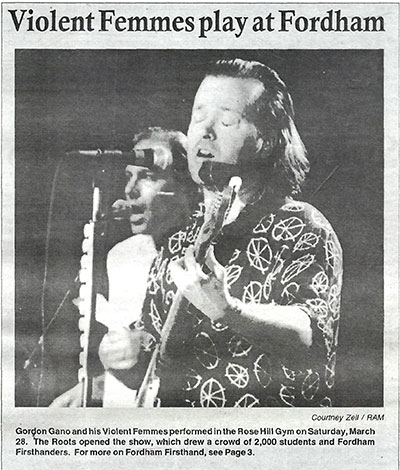 American alternative rockers the Violent Femmes played at Rose Hill 15 years after the release of their popular self-titled debut album. Known for their jittery yet melodic sound and eternally appealing odes to teenage angst (burger chain Wendy’s used “Blister in the Sun” in their 2007 TV ads), the Milwaukee band was still releasing albums and touring in the ’90s. They reunited in 2013, playing at the Coachella festival.
American alternative rockers the Violent Femmes played at Rose Hill 15 years after the release of their popular self-titled debut album. Known for their jittery yet melodic sound and eternally appealing odes to teenage angst (burger chain Wendy’s used “Blister in the Sun” in their 2007 TV ads), the Milwaukee band was still releasing albums and touring in the ’90s. They reunited in 2013, playing at the Coachella festival.
The Roots, considered by many to be the best live hip-hop band, released their breakthrough album Things Fall Apart the year after playing at Fordham. But by 1998, critics had already lauded the future Grammy Award winners for their jazzy, funky approach to the genre. Today the Roots serve as the house band for Late Night with Jimmy Fallon.
Adele
June 9, 2008
Studio A at WFUV
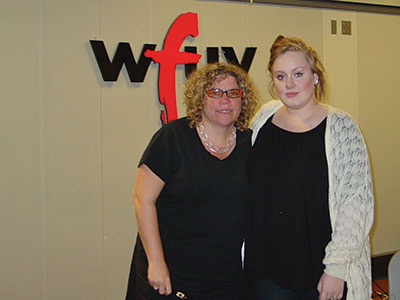
Pop sensation Adele did one of her first U.S. radio interviews at WFUV in 2008, just after the American release of her debut album, 19.
When Rita Houston, WFUV’s music director, heard the young singer perform that day, she had a sense that she’d make it big. “There was something that was so honest about what she was doing,” Houston says. Adele returned to FUV after releasing 21, which won the 2011 Grammy Award for Best Album of the Year.
U2
March 6, 2009
Edwards Parade
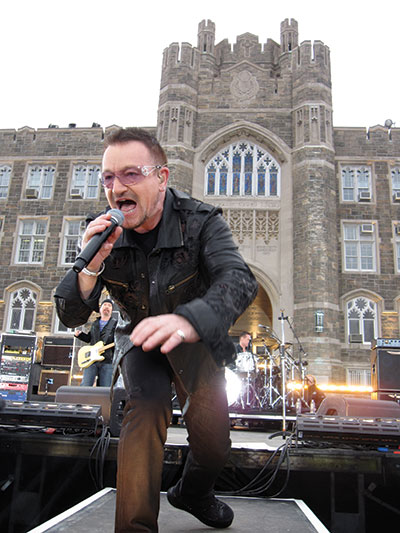
“It was just a rumor for the longest time, but we were very excited. We all knew something was coming,” says Dennis Elsas, WFUV’s afternoon host. “There was great anticipation at the thought that one of the biggest bands in the world was going to be coming here, literally on the steps of Keating Hall.”
Elsas, a recognized rock authority who spent 25 years at New York’s WNEW as a DJ and music director, has interviewed rock’s greatest legends, including John Lennon, Mick Jagger, and Pete Townsend. “I’ve been involved with many shows,” he says, “but they were a hundred yards from our studio—less—it was our backyard!” Between the staff from Good Morning America, which was broadcasting the show live, U2’s security, and University security, it was tough even for Elsas to get near the Irish rockers. But he made his way to the stage, where he filed reports for WFUV.
The group played beautifully to the Fordham crowd, Elsas says. Front man Bono reminisced about how he and his bandmates got together when they were in their teens. “We joined a band to get out of going to college,” he said, “but maybe if it looked like this and felt like this, things could have been different.”
“There was a tremendous sense of pride [that day],” Elsas says. “It was both rock and roll and Fordham history.”
MGMT
May 1, 2010
Martyrs’ Court Lawn
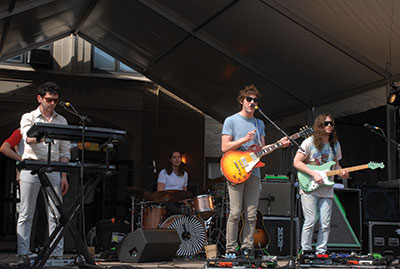
At Spring Weekend 2010, student bands Average Girl and Penrose opened for the Brooklyn-based synthpop sensation MGMT, which had just released its second album, Congratulations. The band, hot off an April 24 performance on Saturday Night Live, played all of its hits, including the electrodisco anthems “Kids” and “Time to Pretend.”
Emeli Sandé
February 27, 2012
Studio A at WFUV
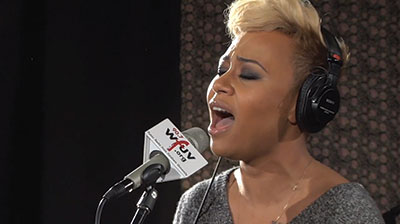
Emeli Sandé chose FUV for her first American radio interview after the release of her debut album, Our Version of Events, which later reached No. 1 in the United Kingdom. “She was just lovely and so self-possessed,” Houston says of the singer, who grew up in Scotland. “Her songs knocked me out.”
The 26-year-old songwriter has penned tunes for Alicia Keys, Rihanna, and many others. At Fordham, she performed stripped-down versions of her own soulful hits, including “My Kind of Love.” The YouTube videos of her FUV Studio A session have received more than 1 million hits combined, possibly due to her growing popularity after performances at the London Olympics in summer 2012 and at the White House in May.

